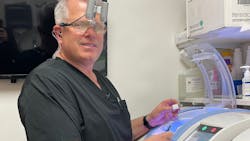Fully integrated technology in Planmeca’s new chairside dentistry solution
Being an early adopter of chairside milling and CAD/CAM digital dentistry has provided numerous opportunities for me over the last few decades. I have access to the latest technology, even before it’s been released to the public. I’ve participated in rigorous beta testing programs with several manufacturers and delivered honest feedback to help companies bring better products to market.
Recently, I was tasked with putting Planmeca’s new FIT CAD/CAM system through its paces. I have a busy general dental practice in Elkhart, Indiana, and offer comprehensive general, cosmetic, and sedation dentistry. My office is an ideal testing ground for a system like this. I have a long-standing relationship with the
Planmeca R&D team working with their mills and intraoral scanners.
So, what’s different about this new system? A lot. All three components have been significantly improved, making this a more flexible system and an ideal fit for any general dental office.
Related reading: How diagnostic technologies impact your practice and ROI
The Emerald S intraoral scanner’s speed has been dramatically improved, and it’s also incredibly easy to use. All three of my assistants have found the scanner to have a short, almost nonexistent learning curve. They can scan an arch in about a minute.
Additionally, the PlanCAD software has been completely reengineered within the Planmeca Romexis platform. Although it has always been an integrated part of the software, now it’s more seamless than ever. Clinicians can simply design, plan, and perfect their restorations within a single system. I also have Planmeca’s 3D imaging technology, and I love the simplicity of working within Romexis. I never have to launch a different software or import/export files to another software. The system delivers on the promise of digital dentistry—efficiency.
Lastly, the new Planmeca PlanMill 35 is the perfect mill for any dentist just entering into the realm of CAD/CAM dentistry or dentists who already have an intraoral scanner and are now ready to do their own in-office lab work. The PlanMill 35 offers versatility in material selection. You can mill a multitude of materials, including zirconia, glass and hybrid ceramics, composite, and more.
I’ve found this mill provides accuracy and efficiency with minimal maintenance and downtime, especially when switching between wet and dry. I’ve personally pushed this mill to the limits, constantly switching back and forth with the intention of causing it to malfunction . . . and it just hasn’t. I have three older Planmeca mills and all three are still working in our office today. The oldest unit is from 2009, and even after 13 years we continue to use it daily. These mills are workhorses built to last for years.
Overall, I think Planmeca has a great new product for any dentist who wants to bring restorative work in-house. It enables doctors to provide onlays, inlays, crowns, veneers, and three-unit bridges in a single visit with greater control of esthetics, quality, and outcome. And the price isn’t exorbitant. With the newfound lab savings, the unit will pay for itself quickly.
Editor's note: This article appeared in the March 2022 print edition of Dental Economics. Dentists in North America are eligible for a complimentary print subscription. Sign up here.
About the Author
William Flora, DDS
William Flora, DDS, has been in practice for more than 26 years. He is an active member of the American Academy of Cosmetic Dentistry and a fellow of the International College of Oral Implantologists. Dr. Flora has achieved master level status from the Center of Esthetic Excellence. In his practice he offers advanced dentistry such as orthodontic work, implant placement, TMD treatment, and smile design.
Updated February 7, 2022

